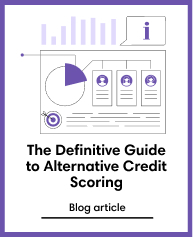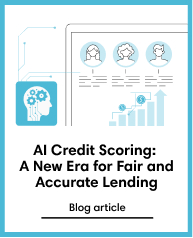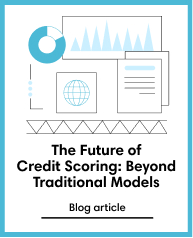Credit Scoring
Feb 17, 2022
The relationship between data collection and credit scoring
Subscribe to our newsletter
Introduction
According to the latest World Bank study, 1.7 billion adults currently have no access to a bank account.
Credit scoring is a core part of digital lending, helping lenders evaluate who qualifies for a loan and under what terms.
As more people access credit via smartphones, the link between data collection and credit scoring becomes stronger.
Traditional scoring relies on credit history, but modern credit scoring models now incorporate real-time behavioural and mobile data to improve credit decisions and increase financial inclusion.
Here, we will explore how data collection, including behavioural and mobile data, impacts credit scoring, risk modelling, and financial inclusion in today’s digital economy.
How Data Collection Affects Credit Scores
Wondering how data collection affects credit scores? The data a lender collects directly shapes the accuracy and fairness of credit scores.
Traditional credit scoring relies on credit bureau records, reflecting only past financial interactions. This often excludes responsible borrowers without documented histories.
With behavioural analytics and alternative credit data, lenders can assess real-time indicators, like mobile usage and payment behaviours. These signals enhance decision-making with a more comprehensive view of creditworthiness.
Accurate, consented data collection improves models, reduces fraud, and expands access—showing the growing importance of alternative data in credit scoring for inclusion and approval accuracy.
Traditional vs Alternative Credit Data Sources
Traditional Credit Data
Traditional credit scoring models rely heavily on historical data from financial institutions. This includes:
- Repayment history
- Existing loans and credit cards
- Credit utilisation
- Length of credit history
- Number of open accounts
Expanding the sources of credit scoring data allows lenders to move beyond traditional risk signals and evaluate borrowers with greater precision.
Credit bureaus convert this data into a score, which is beneficial for those with a banking history but excludes individuals without formal credit.
This credit rating results from a previous credit analysis, which may vary depending on the institution that performs it.
For the 1.7 billion unbanked globally, there’s no entry point. These models also penalise short or inconsistent histories, leading to high rejection rates or interest.
This limits the reach of credit risk modelling that relies solely on traditional sources.
Alternative Credit Data
The uprising of new fintech companies has allowed more people to have access to financial products.
To serve a broader population, many fintechs and lenders are embracing alternative credit data.
Unlike traditional data, this includes behavioural and digital footprints that can indicate creditworthiness even in the absence of prior credit.
Some key alternative data points include:
- Mobile metadata: swipe speed, typing patterns, app usage
- Device signals: operating system, battery levels, security settings
- Utility and rent payments
- E-wallet and mobile money usage
- Psychometric assessments and survey responses
- IP geolocation, email domain validity, and telecom signals
- Social media presence and device integrity
With over 11 million data points extracted via Credolab’s SDK, machine learning in credit scoring can process behavioural signals in real-time, resulting in more reliable, inclusive, and fraud-resistant credit scores.
These indicators enable lenders to create a more dynamic credit profile that adjusts over time.
For example, a user’s smartphone usage and payment behaviours may evolve, and so will their creditworthiness.
This kind of credit data analysis supports more inclusive lending. Learn more about alternative credit scoring data.
The Role of Behavioural and Mobile Data in Credit Scoring
Behavioural and mobile data have revolutionised how lenders assess risk, especially in markets where traditional credit data is limited or unavailable.
Rather than relying solely on credit bureau records, lenders now tap into smartphone metadata to gauge user behaviour.
This includes how a person interacts with their device—tap speed, typing rhythm, app usage frequency, and even battery patterns.
These seemingly small actions reveal larger behavioural trends such as reliability, stability, and intent to repay.
Mobile data for credit scoring, when captured with consent, offers a continuous and passive stream of information that is harder to fake than self-reported or historical financial data.
It provides insights into a user’s digital lifestyle—such as the consistency of app usage, location stability, and device security settings—which often correlate with financial behaviour.
Behavioural data for credit scoring, collected through SDKs like Credolab’s, allows for the creation of real-time risk scores without requiring personal or intrusive data.
It helps lenders understand new-to-credit customers and reduce fraud by assessing behavioural integrity.
Credolab processes over 11 million behavioural signals from mobile devices to generate privacy-preserving, explainable credit and fraud scores.
This real-time digital credit scoring helps lenders assess applicants instantly—especially those new to credit—making the process faster, more inclusive, and scalable through behavioural and mobile data.
Enhancing Credit Assessment with Predictive Analytics
Predictive credit analytics uses data science and machine learning in credit scoring to forecast default risk by analysing structured and unstructured data, from repayment history to smartphone metadata.
These models enhance credit assessment by identifying patterns that traditional scores miss.
Unlike static scorecards, predictive models evolve with new data—learning from behaviour, income stability, and mobile app usage to better differentiate high-risk from low-risk applicants in real time.
These insights enable lenders to make faster, more confident decisions.
With predictive credit analytics, financial institutions can reduce defaults, expand their customer base, and deliver fairer credit outcomes.
As lenders embrace broader data strategies, financial data analysis plays a critical role in identifying patterns that traditional models often overlook.
Credit Risk Modelling and Decisioning
Credit risk modelling is the backbone of any lending strategy. It combines statistical analysis with real-world data to estimate the probability that a borrower will repay a loan.
Modern credit risk modelling goes beyond credit history—they use device data, behavioural trends, and real-time signals to predict outcomes more accurately.
Credit decisioning involves applying these models during the credit application process.
With tools like Credolab’s SDK, lenders can embed risk scores directly into onboarding flows. This enables instant decisions, minimises manual checks, and improves operational efficiency.
The result? Faster approvals, reduced fraud, and more inclusive lending—all powered by smarter credit risk modelling.
Benefits of a Data-Enriched Credit Scoring Strategy
Complete Credit Profiles
By including alternative credit data, lenders gain a 360-degree view of applicants. Rather than relying solely on repayment history, they can assess behaviours that indicate financial intent and consistency.
This kind of data enrichment allows lenders to:
- Approve thin-file or first-time borrowers with confidence
- Create credit scoring models that reflect real-time applicant behaviour
- Minimise false declines and expand credit access across demographics
By integrating behavioural data for credit scoring, lenders can better understand user intent and financial habits, especially among new-to-credit borrowers.
Better Fraud Prevention and Data Security
Traditional models are susceptible to identity fraud and phishing. Alternative systems, especially those based on machine learning and behavioural analytics, can detect unusual or manipulated activity before it causes harm.
Credolab’s solution, for instance, uses behavioural biometrics to flag device manipulation and synthetic identity attempts.
Since the data collected is anonymised and never includes personal content, privacy remains protected.
Moreover, all metadata collected by Credolab is non-PII data, non-personally identifiable information and fully encrypted. This ensures compliance with global regulations such as General Data Protection Regulation (GDPR), Lei Geral de Proteção de Dados (LGPD), California Consumer Privacy Act (CCPA), and Ley Federal de Protección de Datos Personales en Posesión de los Particulares (LFPDPPP).
In an age of rising cyber threats, this approach prevents unauthorised access while enabling better decision-making.
Faster Approvals Through Automation
A major advantage of modern data collection systems is speed. By using embedded scoring and real-time machine learning analytics, lenders can process applications in seconds, not days.
This not only improves the user experience but also reduces drop-offs. Borrowers expect quick results, and delays often lead them to explore competitors.
Credolab clients have reported a 60% reduction in time-to-approval and increased conversion rates by automating decision workflows with embedded credit and fraud scores.
Use Cases and Real-World Examples
In emerging markets, where credit bureau coverage is limited or outdated, lenders are turning to mobile behavioural data to make better lending decisions.
For instance, digital lenders and microfinance institutions in Southeast Asia, Africa, and Latin America use smartphone metadata to assess borrower intent, stability, and fraud risk—especially for thin-file customers.
Buy Now, Pay Later (BNPL) providers have also embraced predictive credit analytics to evaluate risk in real time.
By integrating SDKs like Credolab’s into their apps, they score customers instantly based on how they use their devices—without needing traditional credit data.
A micro-lender in Africa recently reduced default rates by roughly 30% through behavioural scoring using mobile usage patterns. Likewise, a Latin American fintech enhanced approval accuracy by continuously updating its credit scoring models with fresh data insights.
These developments illustrate the growing impact of AI-driven credit assessment.
Conclusion
Alternative credit scoring and the way we collect and use data in credit scoring is evolving—and with good reason.
Traditional credit risk modelling systems fail to account for the financial lives of millions who transact digitally, live outside the formal banking ecosystem, or are just beginning their credit journey.
By embracing alternative credit data, lenders can break the cycle of exclusion.
Whether it is behavioural metadata, mobile usage patterns, or non-traditional financial indicators, these signals provide a more accurate, inclusive, and secure foundation for credit scoring.
Credolab’s privacy-first credit risk modelling solutions are built to harness this data ethically and effectively—bringing meaningful change to financial inclusion worldwide.
FAQs
How does data collection affect credit scores?
The type and quality of data collected directly influence how accurate and inclusive a credit score is. Broader data sources lead to better insights.
Is behavioural data reliable for credit scoring?
Yes, when processed using validated machine learning in credit scoring models, behavioural data offers strong predictive power for assessing intent and risk.
What is considered alternative credit data?
It includes utility bills, rent payments, mobile usage, device metadata, and psychometric surveys—data beyond traditional credit bureaus.
How is mobile data collected and used securely?
With user consent, anonymised metadata is collected via SDKs like Credolab’s. It is encrypted and compliant with global privacy laws.
Can predictive analytics improve credit risk decisions?
Absolutely. It enables real-time, data-driven risk assessments that reduce defaults and expand access to responsible lending.





